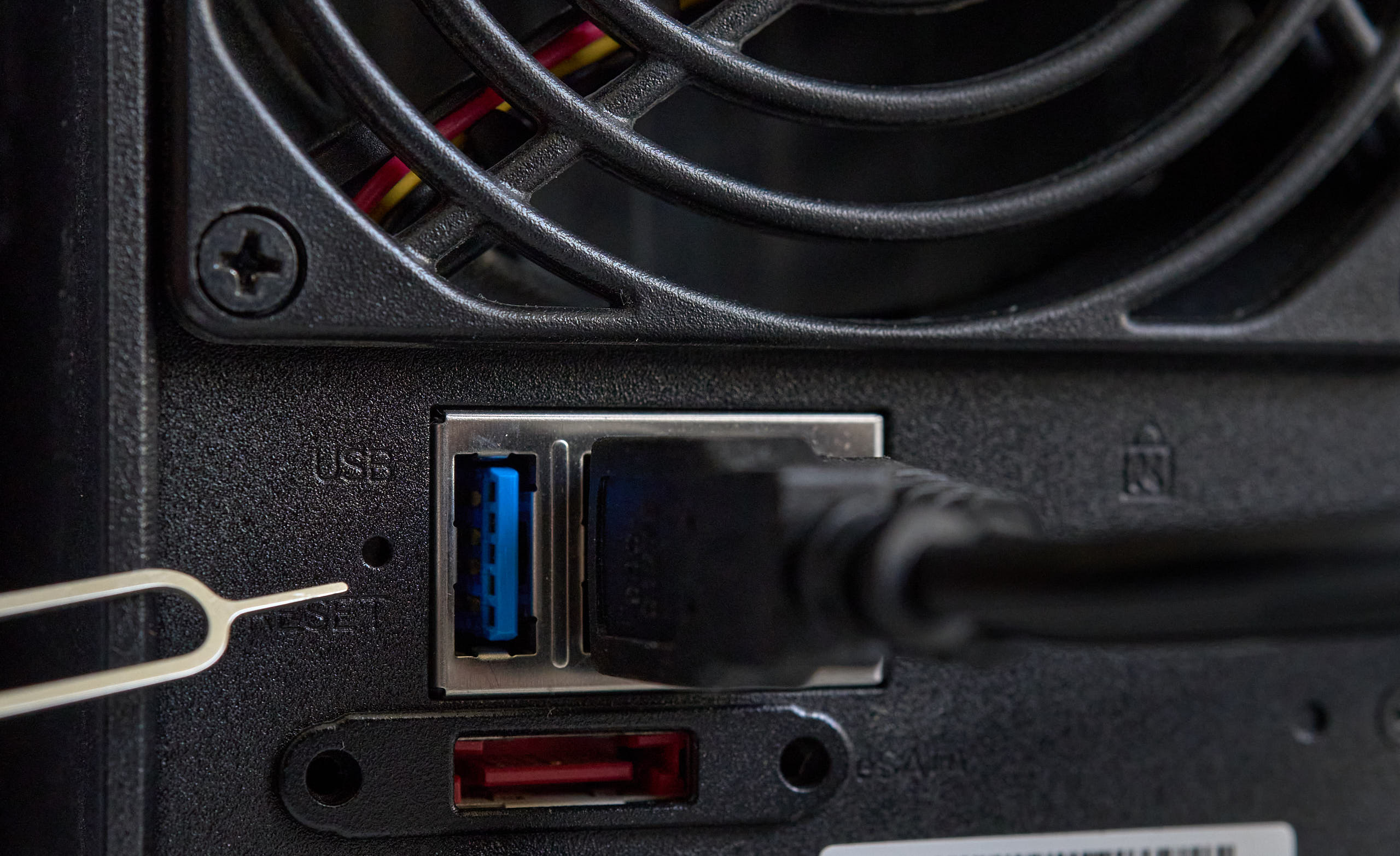You may not be able to connect to a NAS or log in with administrative rights. A Synology NAS has basic reset functionality built-in without affecting the data on it. Learn when and how to reset your NAS and get access again.
This post is donation-ware. If it did help you, please consider leaving a comment or even buying me a coffee. I will be eternally grateful.

How To Reset A Synology NAS
Hidden to prevent accidental use, each Synology NAS has a reset button at the back. If you can not find it, look it up in the hardware guide of your model. To press that little button, you need a paperclip.
There are two types of reset, Mode 1 and Mode 2, and Synology describes each briefly in their DiskStation Manager tutorial.
I will describe the when and how of both reset modes in more detail and add the factory reset to it. Note that a reset does not necessarily mean wiping your disks. A reset means that you reset some settings to solve some fundamental issues.
A factory reset does wipe your disks and brings your DiskStation into a state like when it left the factory.
Types of reset
There are several types of reset for your DiskStation, and each type serves a specific purpose. The following paragraph briefly outlines each type.
- Mode 1 reset
Its purpose is to restore access to a DiskStation and allow you to log in with administrative privileges; no user data is erased; - Mode 2 reset
Its purpose is to reinstall the DSM software of the NAS in case it is damaged; no user data is erased; - Factory reset
Its purpose is to wholly wipe the NAS, for example, for sale or before replacing the disks; all user data is erased.
According to Synology, both the Mode 1 and Mode 2 resets affect the DiskStation configuration, not the drive’s data, like your shared folders and files. In contrast, a factory reset, which I will discuss here, erases the DiskStation configuration and your data.
When To Do A Mode 1 Reset
Your first step in resetting a Synology DiskStation is a Mode 1 reset. A Mode 1 reset is helpful if you cannot reach a NAS due to an incompatible network configuration, no administrative access, etc.
Network issues
For example, your DiskStation has a fixed IP address, and you moved it to another location with a different subnet. Or you have replaced your router, which has another subnet than your previous model.
Maybe you configured link aggregation, but the configuration did not work well. Another mishap can occur if you accidentally configure a restricted network port in your browser. Or the firewall is preventing access to your DiskStation.
In either case, you can have difficulties accessing your DiskStation.
Administrative issues
Another scenario is that you can access your NAS but can not log in as an administrator. You have to administer a DiskStation, but you have no administrative account, and the default admin account is disabled (as it should be), or the password is unknown.
In particular, for administrator accounts, two-step verification is another cause of not accessing a NAS. You might have lost your smartphone for the codes, or you do not have access to the email for an emergency code, or you reached your limit of five codes.
This reset disables two-factor authentication for the default admin account. If you configure two-factor authentication in Control Panel, it is removed from the admin account and moved to other administrator accounts to their settings.
In case you blocked yourself from logging in due to failed login attempts, a Mode 1 reset helps you out, thanks to Auto Block. The reset disables Auto Block.
Note that the Allow/Block List is unaffected by the reset. As a result, do not forget to clear the block list after enabling Auto Block again.
To summarize, a Mode 1 reset includes the following:
- the admin account is enabled with a blanc password, and two-factor authentication is removed
- the network ports for logging in to DSM are reset to the default 5000/5001
- HTTP to HTTPS redirect for DSM desktop is removed
- All network interfaces are reset to DHCP
- PPPoE is disabled
- Auto Block is disabled
- Firewall rules are disabled
- The high-availability cluster is removed
- The virtual Machine cluster is removed
- encrypted folders are unmounted, and automount on startup is disabled
How To Do A Mode 1 Reset
For a Mode 1 reset, reach for the reset button at the back of your DiskStation. It is hidden and, if necessary, refer to your device’s user guide. Make sure the DiskStation is running. Now, press the reset button for about four seconds until you hear a beep. You then release the reset button.
The admin account is enabled (again), and it has no password, but a password change is required when using it. Other users and their passwords, including any custom administrator account, remain unaffected by a Mode 1 reset. The reset restores the network settings. It reverts the LAN interfaces to DHCP. Two-step verification is disabled as well as Auto Block.
Applications and their data and all folders and files, users, and groups remain unaffected by a Mode 1 reset.
Tip
Use the Synology Assistant program to find and log in to the NAS after this reset or the Synology Web Assistant at http://find.synology.com.
Tip
After finishing your necessary configurations, log in to DSM with another administrator account and disable the default admin account.
Tip
Select the Reset tab in the Control Panel, Update & Restore (System section). Under Reset Option, you will find a checkbox to Keep current admin password unchanged.
When you enable this option, the admin password remains unchanged after a Mode 1 reset, and it does not clear the password as described above.
This feature prevents someone who steals your NAS from accessing all your data after a Mode 1 reset. However, before enabling this option, you have to make sure you don’t lose your admin password from the default admin account or any custom administrative account if you need a Mode 1 reset yourself. A password manager is an excellent help for that.
When To Do A Mode 2 Reset
A Mode 2 reset is valid when the DSM software or the NAS configuration is damaged so that you can no longer use it. You typically can not connect to your shares, and you are not able to log into DSM.
A Mode 2 reset comes immediately after the Mode 1 reset. So you first perform a Mode 1 reset and directly proceed for a Mode 2 reset, and it works as follows.
How To Do A Mode 2 Reset
You press and hold the reset button for about four seconds until you hear a beep. You then release the reset button. This beep is the Mode 1 reset.
Immediately press the reset button again. After about four seconds, you will hear three beeps, and you rerelease the reset button. Next, you then wait about two minutes. The Mode 2 reset is complete.
After a Mode 2 reset
Now find the NAS with the Synology Assistant program or the Web Assistant at http://find.synology.com.
If you connect to the NAS after a Mode 2 reset, a message appears stating that you can reinstall it because the NAS has been reset. The reinstallation starts immediately with the installation of DSM.
You also create your administrator account with a password and give your NAS a name during the reinstallation. Note that a Mode 2 reset clears the system configuration, including users and groups and all installed applications and their data.
However, the shared folders and files are all still there. The disks are not erased, and the disk configuration like volumes and storage pools remains intact.
After the DSM installation, you can log in and start repairing by creating users and groups. A quicker way is to restore a configuration backup. Below, you can read how to make such a backup and restore it.
Factory Reset
In addition to a Mode 1 or Mode 2 reset, you can also reset the DiskStation to its factory settings. The Factory Reset will cause all user data to be lost on the hard drives.
With a factory reset, you can completely wipe your DiskStation. You might want to do that before you sell it, plan a reinstallation for a different purpose, or need to wipe your disks before replacement.
You perform Factory Reset from DSM. Log in to DSM with an administrator account. Open Control Panel > Update & Restore (System section), select the Reset tab. Under Factory Reset, you see a red button Erase All Data.
When you click on this button, you are obviously on your way to erasing all data. You first will get another confirmation screen where you have to tick a box before continuing.
Configuration Backup
A Mode 2 reset clears the system configuration and reinstalls DSM. To recover from the wiped system configuration, you can make a configuration backup beforehand and restore it later. You can make a configuration backup in three ways:
- with Control Panel, you save the system configuration on your computer
- as part of a Hyper Backup backup
- automatically store it online with your Synology account; this requires DSM7
The configuration backup does not contain all the system configuration data but includes users and groups.
From DSM, open Control Panel, go to Update & Restore, and select the Configuration Backup tab. Click on the Backup configuration button to create a backup .dss file and download it to your computer’s Download folder.
The Restore configuration button lets you open a .dss file from your computer and restore it. Note that the restore lets you choose what information you like to restore. You do not necessarily have to restore all the configurations that the backup contains.
The configuration backup contains:
- All System Configurations
- User, Groups, and Shared Folders
- User
- Group
- Shared Folder
- Workgroup, Domain, and LDAP
- File Sharing and Backup Services
- SMB
- AFP
- NFS
- FTP
- Advanced
- Network Backup
- Other Services
- User Home
- Password Expiration
- SNMP
- Task Scheduler
- DHCP Server
- Notification
- User, Groups, and Shared Folders
Intended use
Although a configuration backup only covers a part of the system configuration, you are encouraged to create this backup regularly. Note that any Hyper Backup task includes the same configuration backup, so you can skip the configuration backup as a separate task if you use Hyper Backup.
Thanks for reading
This post is donation-ware. If it did help you, please consider leaving a comment or even buying me a coffee. I will be eternally grateful.
Paul Steunebrink / Storage Alchemist

There are two types of reset, Mode 1 and Mode 1,
Thanks. I corrected the typo.